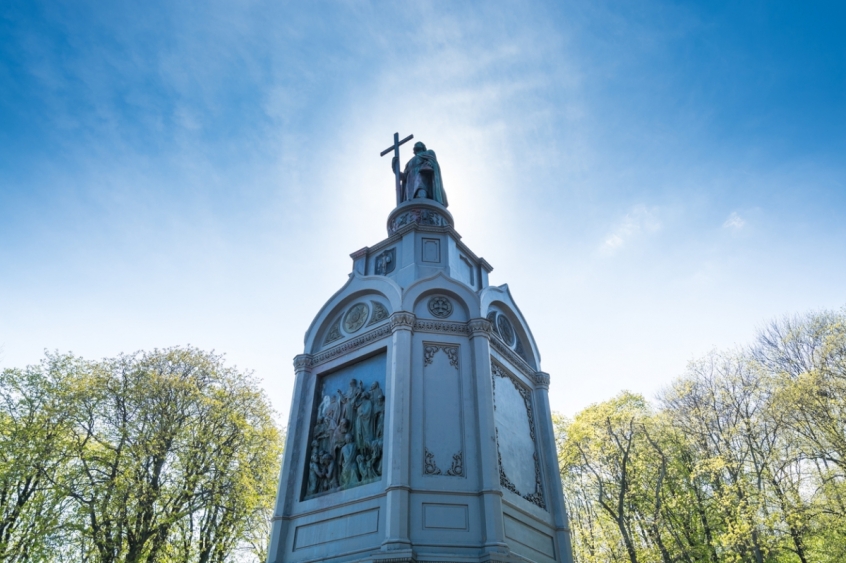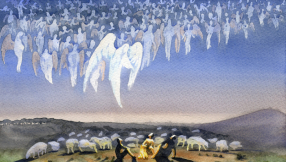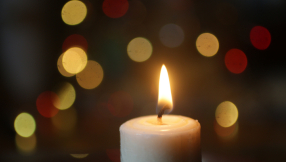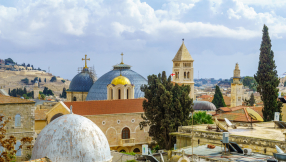
The writer of the Letter to the Hebrews reminds Christians that they are surrounded by a great "cloud of witnesses." (NRSV) That "cloud" has continued to grow in size since then. In this monthly column we will be thinking about some of the people and events, over the past 2000 years, that have helped make up this "cloud." People and events that have helped build the community of the Christian church as it exists today.
In Borovitskaya Square, in central Moscow, stands a 17.5-metre-high monument to 'St Vladimir the Great'. He is credited with the introduction of Orthodox Christianity to Russia and his life and achievements form part of what we might call the 'deep story' of Russia and Ukraine and their common Christian faith.
The figure, holding a giant cross, was erected in 2016 on the initiative of the Russian Military Historical Society and the city government of Moscow. It was unveiled by his namesake – Vladimir Putin, President of the Russian Federation.
St Vladimir the Great and 'the war for the soul' of Russia and Ukraine
The erection of the statue was immensely controversial because St Vladimir – called St Volodymyr in Ukraine – is claimed by both Russia and Ukraine as a founding father and many Ukrainians considered it a provocative gesture.
It was highly significant that the statue was unveiled on 'National Unity Day' in Russia – a national holiday revived by Putin in 2005. At the time, many Ukrainians felt that the action was a deliberate attempt to challenge the idea of Ukrainian sovereignty and cultural independence. This was being done by 'weaponizing' the saint, in the cause of Russian nationalist claims regarding the Ukrainian state that they traditionally describe as 'Little Russia'.
The deep division between these two Orthodox nations was further revealed in 2019 when the Ukrainian Orthodox Church became independent from the Russian Orthodox Church, much to the anger of both the religious and political authorities in Moscow.
In July 2021, Putin published a lengthy article entitled 'On the Historical Unity of Russians and Ukrainians,' which made it clear that reunification was on his agenda.
Finally, in 2022, the full extent of that weaponizing of history has been seen in the Russian military columns, bombers and missiles descending on Ukraine in an attempt to abolish its independence.
Which raises the question of who was St Vladimir/Volodymyr and how did he come to occupy such a contested place in the hearts and minds of two nations that are now locked in bitter warfare? The answer involves Vikings far from home, a reluctant Byzantine princess, the creation of a hybrid national identity, and conversion to Christianity.
Vladimir/Volodymyr and the origins of the 'Rus'
Beside the driveway of Gripsholm Castle in Sweden, stands an eleventh-century runestone. It reads (when translated): "Tola had this stone raised in memory of her son Haraldr, Ingvarr's brother. They travelled valiantly far for gold, and in the east gave (food) to the eagle. (They) died in the south in Serkland."
The "Serkland" referred to on this and on four other runestones was the name used by Scandinavians for the Islamic Abbasid Caliphate and other Muslim areas of the east. This particular expedition to the Caspian Sea – down the rivers of what is now Russia – is mentioned on more runestones than any another event in Swedish Viking history. However, it was not an isolated journey.
Read More: A crucifixion in Cambridgeshire
We associate Vikings with the stormy seas of the northern world, with Scandinavian fjords, with the cold of Iceland, and with attacks on the monasteries of north-western Europe. It is less in the popular image to include the rivers of Russia and Ukraine, the Eurasian steppe, the shores of the Caspian Sea, slave markets and Arab traders, flame-throwing ships, the ritual and drama of the Eastern Orthodox Church, and the walls and towers of Constantinople.
And yet for many Swedish Viking raiders, traders and settlers, it was the road to the east that beckoned. This eastward movement started as early as AD 650 as archaeology reveals the graves of Scandinavians (almost certainly merchants) in eastern Baltic settlements of the Slavs and Balts, such as that at Elbing (now Elblag in northern Poland).
By 750, other Scandinavians were settled in the Finnish trading settlement of Staraja Ladoga (on the River Volkhov, near Lake Ladoga in north-west Russia). These Viking settlers would be remembered in later legends and chronicles as the 'Rus' and 'Varangians'. The word 'Russia' is derived from the first of these Viking-Age words.
The further penetration of Viking 'Rus' into eastern lands was assisted by the river geography of Russia – hence the word 'Rus' meaning 'rowers'. Just south of Novgorod are the headwaters of rivers which, between them, flow to the Gulf of Finland, the Gulf of Riga (both giving access to the Baltic), the Black Sea, and the Caspian. With their strong construction and shallow draughts, Viking vessels were ideally suited to exploit these river routeways.
It was travel on this river system which brought Vikings to what is now Ukraine. Two Rus leaders – traditionally named as Askold and Dir – travelled southward down the River Dneipr and captured the settlement we now call Kyiv (Kiev in Russian). Their settlement at Kyiv soon became deeply enmeshed in a wide-ranging trading network that linked the Baltic to the Black Sea, the Caspian Sea – and beyond.
READ MORE: The strange decline of US evangelicalism
The third ruler of Kyiv was later remembered as Igor (he probably called himself by the Norse form 'Ingvar'). The Viking Rus culture was increasingly mixed with the majority Slavic population, as was reflected in their names and religious beliefs. In 945, Igor's son came to power; he was named Svyatoslav and he and his son, Vladimir, were both worshippers of the Slavic god, Perun.
The conversion of the Rus to Christianity
The story of how the conversion occurred has the hallmarks of legend. The 'Russian Primary Chronicle'recounts how Prince Vladimir had decided to abandon the traditional paganism of the Vikings and the Slavs. In this he was encouraged by the example of Olga his grandmother, who had already converted to Greek Orthodox Christianity. But which faith should Vladimir adopt? He was undecided.
According to one traditional account, he dispatched emissaries to different parts of Europe to explore the religions that they found there. Other versions say he summoned representatives to Kyiv. These included: representatives of western Roman Catholicism; Jews from among the Khazars who had adopted Judaism; Muslims from among the Volga Bulghars; and finally, the Byzantine Orthodox Christians of Constantinople.
One by one, or so we are told, Vladimir rejected the faiths: Islam principally due to its prohibition of alcohol and pork, despite Vladimir's initial attraction to the idea of seventy-two virgins awaiting him in paradise; Judaism because the God of the Jews had allowed the chosen people to lose their homeland; Catholicism because he found its rites to be dull and disliked its emphasis on fasting.
However, when Rus had visited the great cathedral of Hagia Sophia in Constantinople they were amazed at its beauty and at the grandeur of its formal liturgy. Having weighed it all up, Vladimir decided that the faith of the Byzantines was the best one. Well, that is how one strand of later tradition recalled the decision.
READ MORE: What the Church has got wrong about the end times - and how it can get it right!
The decision suited the Byzantines too, as it gave them a co-religionist ally north of the Black Sea. This was particularly important as Emperor Basil II was facing the loss of Byzantine Crimea to rebels. It was in this circumstance that, in 988, he proposed an alliance with Vladimir and offered him his sister's hand in marriage on condition that Vladimir accepted baptism. So, Vladimir went to Constantinople and there he accepted Christian baptism and also married Princess Anna. She was not happy but accepted her diplomatic and royal conjugal fate.
Once converted, Vladimir was energetic in applying the new faith. The statue of the Slav god, Perun, was dragged down and beaten; it was then pulled through the River Dneipr to cleanse it. A mass baptism was then arranged in the river and Vladimir let it be known that any who refused baptism would be regarded as his enemy. The threat had the desired effect. The Rus converted to the Orthodox Christian faith of the Byzantine Empire.
The new faith had huge implications for the future development of culture in Kyiv and beyond. The liturgy of the church there would be written in the Cyrillic alphabet which henceforth became the form of writing used in the new state and in Ukraine and Russia to the present day. This also allowed the use of Greek literature, that had been translated for the Slavic peoples, to be deployed in the Rus state. This gave access – via these translations – to Greek science, philosophy, and styles of writing history.
This was the beginning of the Orthodox faith in Ukraine and Russia. It united communities which over history have experienced times both of political unity and separation. When Ukraine became an independent state in 1991 it remained a common shared historic foundation.
The tragedy of a 'weaponized' saint
St Vladimir/Volodymyr and his legacy is at the heart of the shared history and Orthodox identity of both Ukraine and Russia. It is part of the 'deep story' of both nations.
The tragedy is that this shared history has become a weapon in the hands of Russian nationalism in its conflict with Ukraine. In 2022 the legacy of St Vladimir/Volodymyr is overshadowed by the billowing smoke of war.
Martyn Whittock is an evangelical and a Licensed Lay Minister in the Church of England. As an historian and author, or co-author, of fifty-four books, his work covers a wide range of historical and theological themes. As a commentator and columnist, he has written for a number of print and online news platforms; been interviewed on radio shows exploring the interaction of faith and politics; appeared on Sky News discussing political events in the USA; and been interviewed on a number of news platforms regarding the Russian invasion of Ukraine. Recently he has explored the history of repression in Russia, and its continued legacy, in: 'The Secret History of Soviet Russia's Police State' (2020). The exploration of the Viking Rus origins of Ukraine and Russia formed part of his co-written: 'The Vikings: From Odin to Christ' (2018). He has just completed 'Apocalyptic Politics' (2022 forthcoming), which examines apocalyptic beliefs driving radicalization, including in Russia.













